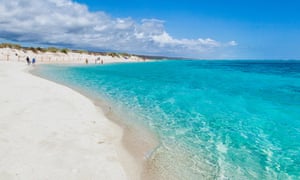Extract from The Guardian
Exclusive: Ocean temperatures to peak at about 1C above average in April, according to forecast, threatening marine life and coral
Western Australia’s coastline is set for a marine heatwave in the early months of 2021, with temperatures rising to their highest level for a decade, according to a newly developed forecast from CSIRO.
Ocean temperatures from Ningaloo to Perth will peak at about 1C above average in April, according to the forecast produced using climate models, observations and machine learning.
The forecast, seen by Guardian Australia, is the first time the technique has been used for an extreme ocean event, CSIRO said.
The forecast covers the part of the state’s coastline that includes the world heritage-listed sites of Ningaloo Coast and Shark Bay – both threatened by warming ocean temperatures.
A major marine heatwave off WA in 2011 had widespread impacts on ecosystems and fisheries and some areas have still not recovered. Corals from Ningaloo to Shark Bay bleached, there were mass fish deaths, vast seagrass meadows were damaged and kelp forests died.
The CSIRO forecast shows temperatures off the coast rising from current average conditions and peaking around April, above the average ocean temperatures calculated between 1982 and 2010.
The Bureau of Meteorology is also forecasting sea surface temperatures up to 1C higher than normal in February and March.
Dr Alistair Hobday, a CSIRO marine scientist leading the new forecasting project, said: “It’s not going to be as warm as the 2011 event, but it’s warmer than we have seen in the last decade.”
He said temperatures across the region were likely to peak at about 1C above average in April, but knowledge of past events suggested temperatures closer to the coast could reach 3C higher than usual.
He said the current La Niña climate phenomenon, a natural event, also tended to deliver warmer waters off WA, strengthening the dominant north-to-south Leeuwin current.
CSIRO has sent the forecast to the WA government to allow fisheries managers and others to prepare.
Hobday said: “We expect to see more extreme event like this under climate change. This is living the prediction. This is a chance to be prepared.”
For example, he said fisheries that use hooks and lines might increase catches because warmer water tended to make fish hungrier. In turn, this could cause a short term over-exploitation of some fish stocks.
Both Ningaloo Coast and Shark Bay world heritage sites had their outlook downgraded in reports from the International Union for Conservation of Nature earlier this month.
Ningaloo’s coral reefs are considered at risk from warming oceans and Shark Bay’s huge seagrass beds have been hit by previous marine heatwaves, in particular the 2011 event.
Research in the journal Nature has found the frequency and length of marine heatwaves around the globe has already increased.
Dr Thomas Wernberg, of the University of Western Australia’s Oceans Institute, said kelp forests along the coastline had still not recovered from the 2011 event.
“Shark Bay’s ecology is completely dependent on extensive seagrass beds that sustain dolphins, dugongs and sharks, and that makes this ecosystem unique,” he said.
He said major fisheries that support the western rock lobster and abalone also relied on healthy seagrass beds.
“We saw extensive impacts on fisheries from the previous marine heatwave. Multiple fisheries were affected and livelihoods were affected. Biodiversity was massively affected across 1,000km of coastline.
“There’s no question that we are seeing a degradation of the environment with impacts from these events that are becoming more frequent, with less time for species to recover.”
Dr Dan Gaughan, the executive director of aquatic science and research at the WA Department of Primary Industries and Regional Development, said the fisheries department was maintaining a “watching brief” on the pending heatwave and had communicated the forecast to the fishing industry.
“Specific locations where a heatwave might cause problems serious enough to negatively impact whole fisheries or fish stocks cannot be accurately predicted, but experience from 2010 and 2011 will guide where the department will focus attention,” he said.
The 2011 event had killed 99% of abalone north of Kalbarri and catches near Perth almost halved for several years. The state’s scallop fishery in Shark Bay and the Abrolhos Islands also collapsed, he said.
Paul Gamblin, director of the Protect Ningaloo campaign group, told Guardian Australia that areas of Ningaloo and Shark Bay were also under threat from industrial development.
He said: “In this context, the spectre of a widespread climate change-driven marine heatwave is deeply concerning for anyone who holds these areas and others along this coast dear to their heart or whose livelihoods depend on it, like tourism operators.”
.png)

No comments:
Post a Comment